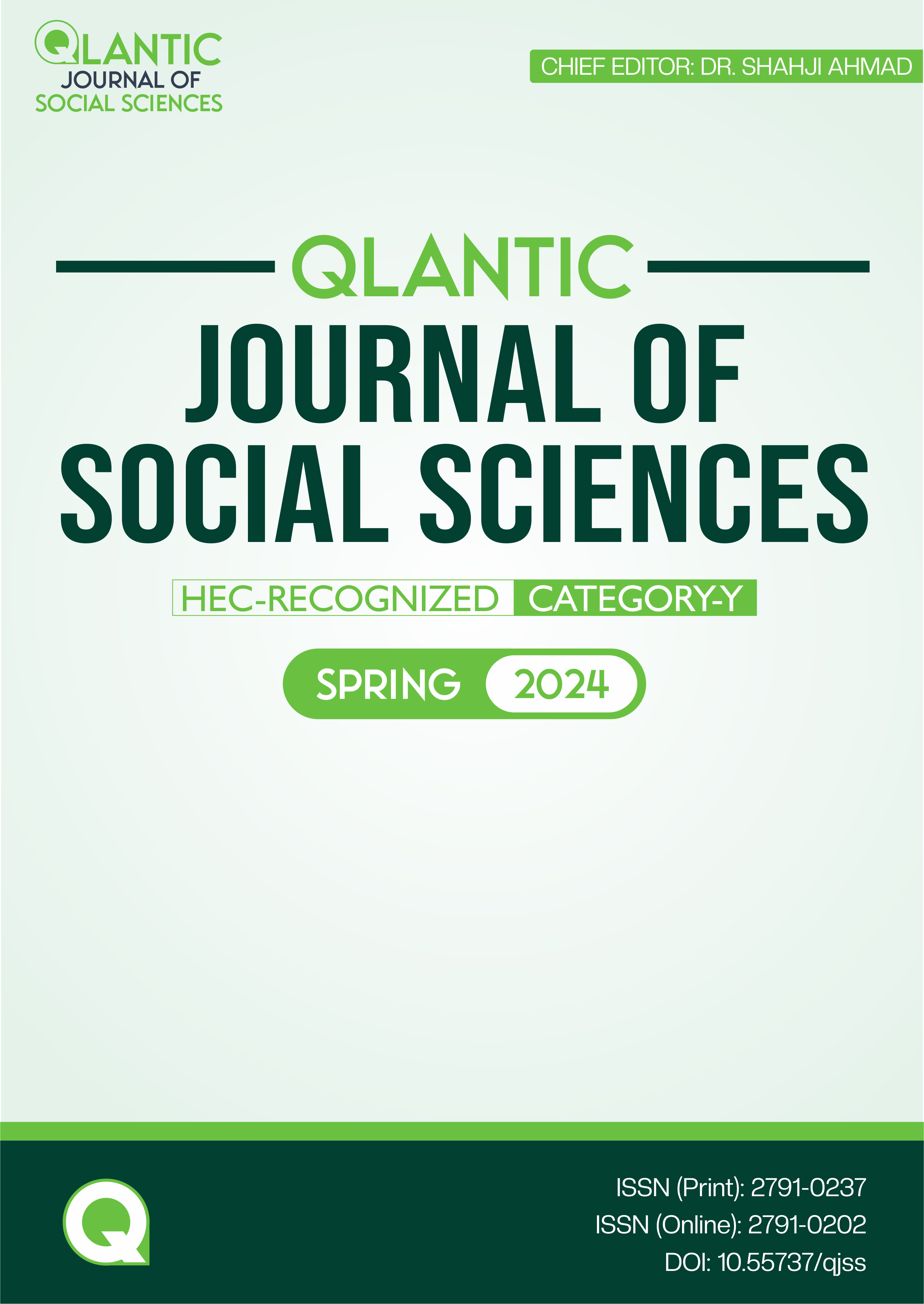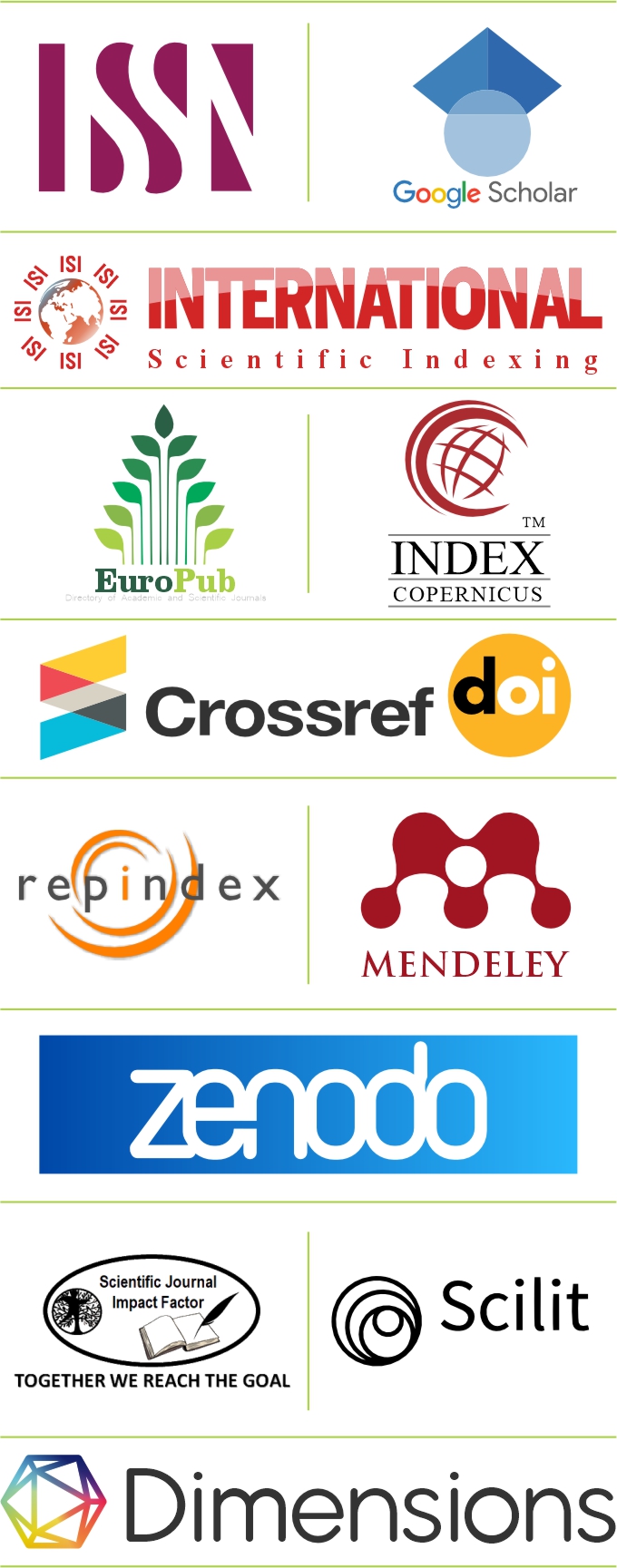Effect of the 7E Learning Cycle Model on Students’ Achievement in the Subject of Science at the Elementary School Level
DOI:
https://doi.org/10.55737/qjss.315497375Keywords:
7E Learning Model, Students' Achievement, Science Literacy, Traditional Instructional ModelAbstract
Innovative teaching strategies help students get an opportunity to think critically and reflect. This study aimed to investigate effectiveness of 7E learning model to teach the science subject to grade VIII students. This quantitative study was carried out at Govt. Girls High School 90 SB Sargodha using intact group sampling. Control group students were taught science subject by traditional instruction method, while experimental group students were taught with respect to sequence of 7E (Elicit, engagement, explore, explain, elaborate, & evaluation) learning cycle model for twelve weeks. Science Achievement Test (SAT) was used as pre-test and post-test. SAT was pilot tested and validated by the science teachers before administration to experimental group. Reliability of test was .92, measured by split-half method. Performance of both groups was compared using t-test. Students taught through 7E instructional strategy scored higher in posttest as compared to students of control group. Findings of this study are useful for developing curriculum material, lesson plans and improving classroom practices. Incorporation of 7E learning cycle model in science curriculum is necessary, so students can construct their knowledge themselves by actively participating in class and create ideas to solve everyday problems.
Downloads
References
Abdi, A. (2014). The effect of inquiry-based learning method on students’ academic achievement in science course. Universal Journal of Educational Research, 2(1), 37-41. https://doi.org/10.13189/ujer.2014.020104
Adesoji, F. A., & Idika, M. I. (2015). Effects of 7E learning cycle model on secondary school students learning outcomes in chemistry. Journal of the International Society, 19(1), 7-19.
Akar, E. (2005). Effectiveness of 5E learning model on students’ understanding of acid-base concepts. [Masters Thesis], Middle East Technical University.
Alam, M. (2016). Constructivism: A paradigm shift from teacher centered to learner centered approach. International Journal of Indian Psychology, 4(1), 51-59. https://doi.org/10.25215/0401.086
Alam., M. (2017). Study of effectiveness of concept attainment model of teaching on achievement in science amongsecondary school students. International Journal of Advanced Research, 5(9), 93-97. https://doi.org/10.21474/ijar01/5305
Alsalhi, N. R. (2023). Academic achievement in chemistry based on the 7e learning cycle model in Jordanian high schools. Journal of International Students, 13(3), 441-459. https://ojed.org/index.php/jis/article/view/6371/2719
Amini, R., & Usmeldi. (2020). The development of teaching materials use an inductive-based 7E learning cycle for elementary school students. Journal of Physics: Conference Series, 1521(4), 042114. https://doi.org/10.1088/1742-6596/1521/4/042114
Anderson, R. D. (2002). Reforming science teaching: What research says about inquiry. Journal of Science Teacher Education, 13(1), 1-12. https://doi.org/10.1023/a:1015171124982
Anisah, F., Sulastri, & Syukri, M. (2020). The effectiveness of 7E learning cycle model to improve student motivation in work and energy topic. Journal of Physics: Conference Series, 1460(1), 012136. https://doi.org/10.1088/1742-6596/1460/1/012136
Balci, S., Cakiroglu, J., & Tekkaya, C. (2006). Engagement, exploration, explanation, extension, and evaluation (5E) learning cycle and conceptual change text as learning tools. Biochemistry and Molecular Biology Education, 34(3), 199-203. https://doi.org/10.1002/bmb.2006.49403403199
Balım, A. G., Türkoğuz, S., Aydın, G., & Evrekli, E. (2012). Activity plans based on 7e model of constructivist approach on the subjects of "Matter and heat" In science and technology course. Bartın Üniversitesi Eğitim Fakültesi Dergisi, 1(1), 128-128. https://doi.org/10.14686/201212005
Balta, N., & Sarac, H. (2016). The effect of 7E learning cycle on learning in science teaching: A meta analysis study. European Journal of Educational Research, 5(2), 61-72. https://doi.org/10.12973/eu-jer.5.2.61
Bentley, M., Ebert, E., & Ebert, C. (2007). Teaching constructivist science, K-8: Nurturing natural investigators in the standards-based classroom. Thousand Oaks, CA: Corwin Press.
Boddy, N., Watson, K., & Aubusson, P. (2003). A trial of 5Es: A referent model for constructivist teaching and learning. Research in Science Education, 33(1), 27-42. http://hdl.handle.net/10453/4991
Bransford, J. D., Brown, A. L., & Cocking, R. R. (Eds.). (2000). How people learn: Brain, mind, experience and school. Washington, D.C: The National Academies Press.
Brown, P. L., & Sandra, K. A. (2007). Examining the learning cycle. Science and Children, 58-59. https://www.sciencefromscientists.org/wp-content/uploads/2017/06/brownandabellearningcycle.pdf
Bruner, J. (1973). Going beyond the information given. New York: Norton. https://www.taylorfrancis.com/chapters/mono/10.4324/9780203088609-8/going-beyond-information-given-jerome-bruner
Cavallo, A. M., & Laubach, T. A. (2001). Students' science perceptions and enrollment decisions in differing learning cycle classrooms. Journal of Research in Science Teaching, 38(9), 1029-1062. https://doi.org/10.1002/tea.1046
Çepni, S., Ayas, A., Ekiz, D., & Akyıldız, S. (2010). Principles and methods of teaching. Trabzon: Celepler Matbaacılı.
Ceylan, E. (2009). Effectivesness of 5E learning cycle model on understanding of state of matter and solubility concepts. Hacettepe University Journal of Education, 41--50.
Curriculum, W. (2006). National curriculum for general science grade VI-VIII. Islamabad: Ministry of Education.
Dewey, J. (1938). Experience and education. New York: Macmillan.
Edmund, A. M. (2008). Why the learning cycle. Journal of Elementary Science Education, 20(3), 63-69.
Eisenkraft, A. (2003). Expanding the 5E model. The Science Teacher, 70(6), 56-59. https://4myfiles.files.wordpress.com/2013/09/expanding-5e.pdf
Erlina, N., Jatmiko, B., & Raharjo, R. (2016). Developing physics learning material based on 7E learning cycle model to improve problem solving skills. Journal of Science Education, 5(2), 1032-1038.
Fardanesh, H. (1999). A critical comparison of systematic and constructivist approaches to instructional design. Modarres Humanities (3), 139-149.
Fardanesh, H. (2006). A classification of constructivist instructional design models based on learning and teaching approaches. Evaluative.
Fatimah, F. M., & Anggrisia, N. F. (2019). The effectiveness of 7E learning model to improve scientific literacy. Advances in Social Science, Education and Humanities Research, 277, 18-22. https://doi.org/10.2991/steach-18.2019.4
Fraenkel, J. R., Wallen, N. E., & Hyun, H. H. (2012). How to design and evaluate research in education (8th ed.). NY: The McGraw-Hill Companies, Inc.
Gall, M. D., Gall, J. P., & Borg, W. R. (2003). Educational research: An introduction (7th ed.). Boston, United States of America: Pearson.
Glynn, S. M., Yeany, R. H., & Britton, B. K. (1991). A constructivist view of learning sciences. In S. M. Glynn, R. H. Yeany, & B. K. Britton, The psychology of learning science (pp. 3-19). Hilldale, New Jersey: Lawrence Erlbaum Associates.
Gök, G. (2014). The effect of 7e learning cycle instruction on 6th grade students‘ conceptual understanding of human body systems, self regulation, scienctific epistemological beliefs and science process skills. Ankara: Middle East Technical University.
Gros, B. (2002). Constructivism and designing virtual learning environment. Society for Information Technology & Teacher Education International Conference 950-954. Nashville: Association for the Advancement of Computing in Education (AACE).
Güçlü, N. (1998). Structuralist method in learning and teaching process. Journal of Faculty of Education, 18(3),
Karamustafaoglu, S. (2010). Evaluating the science activities based on multiple intelligence theory. Journal of Turkish Science Education, 7(1), https://www.tused.org/index.php/tused/article/view/499
Kaynar, D., Tekkaya, C., & Cakiroglu, J. (2009). Effectiveness of 5E learning cycle instruction on students' acievement in cell concept and scientific epistemological believes. Hacettepo University Journal of Education, 37(37), 96-105.
Kazempour, E. (2013). The effects of inquiry-based teaching on critical thinking of students. Journal of Social Issues and Humanities, 1(3),
Koksal, O., & Demiral, E. E. (2017). Examining the impact of english curriculum designed in line with 7e model on academic achievement and retention of 11th grade students. Journal of the Human and Social Sciences Researches, 6(5), 3252-3265. https://hdl.handle.net/20.500.12452/2980
Marfilinda, R., Rossa, R., Jendriadi, J., & Apfani. (2019). The effect of 7E learning cycle model toward student’s learning outcomes of basic science concept. Journal of Teaching and Learning in Elementary Education, 3(1), 77-87. http://dx.doi.org/10.33578/jtleee.v3i1.7826
Mecit, Ö. (2006). The effect of 7E learning cycle model on the improvement of fifth grade students'critical thinking skills. PhD Thesis, Middle East Technical University.
Meldania, N. P. (2013). The influence of learning model 7E learning model containingTri Hita Karana on science learning outcomes of class V students. Primary Education Journal, 2(2), 1-12.
Minner, D. D., Levy, A. J., & Century, J. (2010). Inquiry-based science instruction-what is it and does it matter? Results from a research synthesis years 1984 to 2002. Journal of Research in Science Teaching, 47(4), 474–496. https://doi.org/10.1002/tea.20347
National Committee on Science Education Standards and Assessment. (1992). National science education standards: A sampler. Washington, DC: National Research Council.
National Education Assessment System. (2018). National assessment report 2016. Islamabad, Pakistan: Ministry of Federal Education & Professional Training.
Özmen, H. (2004). Some Student Misconceptions in Chemistry: A Literature Review of Chemical Bonding. Journal of Science Education and Technology, 13(2), 147–159. https://doi.org/10.1023/b:jost.0000031255.92943.6d
PEC Research & Analysis Wing. (2015). Report on grades 5 and 8 exams. Punjab Examination Commission.
PEC, R., & Analysis, W. (2016). Exam analysis report 2016. Punjab Examination Commission.
PEC, R., & Analysis, W. (2017). Exam analysis report 2017. Punjab Examination Commission.
Piaget, J. (1973). To understand is to invent. New York: Grossman.
Rahmayani, A., Jatmiko, B., & Susantini, E. (2016). Learning software development using 7E learning cycle to increase critical thinking of students. Journal of Science Education, 5(2), 957-961.
Remenyi, D., Williams, B., Money, A., & Swartz, E. (1998). Doing Research in Business and Management: An Introduction to Process and Method. London: Sage.
Resnick, L. B. (1983). Mathematics and science learning: A new conception. Science, 220(4596), 477-478. https://doi.org/10.1126/science.220.4596.477
Richardson, V. (2003). Constructivist pedagogy. Teachers College Record: The Voice of Scholarship in Education, 105(9), 1623-1640. https://doi.org/10.1177/016146810310500906
Saab, N., Van Joolingen, W. R., & Van Hout-Wolters, B. H. (2005). Communication in collaborative discovery learning. British Journal of Educational Psychology, 75, 603-662. https://doi.org/10.1348/000709905x42905.
Safdar, M. (2007). A comparative study of ausubelian and traditonal methods of teaching physics at secondary school. PhD Thesis, National University of Modern Languages, Islamabad.
Saka, A., & Akdeniz, A. R. (2006). Genetik konusunda bilgisayar desteki materyal gelistirilmesi ve 5E modeline gore uygulanmasi. The Turkish Journal of Educational Technology, 5(1),
Salehi, M. (2011). Creative teaching methods impacts based on structuralism approaches in improving mathematics performance. Australian Journal of Basic and Applied Sciences, 5(9), 2290-2294. https://ajbasweb.com/old/ajbas/2011/September-2011/2290-2294.pdf
Sari, N. I., Meilinda, M., & Anwar, Y. (2021). The Effect of 7E Learning Cycle Model on the Students’ Critical Thinking Skills. Sriwijaya International Journal of Lesson Study, 1(2), 23–30. https://doi.org/10.36706/sij-ls.v1i2.19
School Education & Literacy Department. (2017). Standardized Achievement Test (SAT)-V Technical and statistical analysis report 2016-17. Sukkur: Government of Sindh.
Settlage, J. (2000). Understanding the learning cycle: Influences on abilities to embrace the approach by preservice elementary school teachers. Science Education, 84(1), 43-50. https://doi.org/10.1002/(SICI)1098-237X(200001)84:1<43::AID-SCE4>3.0.CO;2-F
Setyasih, I., Romadhon, M. V., Amirudin, A., Fatchan, A., & Utaya, S. (2016). The effect of learning cycle 7e model for geographic achievement on multi-ethnic students. Advances in Social Science, Education and Humanities Research, 79, 310-315. https://doi.org/10.2991/icge-16.2017.59
Shaheen, M. N., & Kayani, M. M. (2015). Improving students’ achievement in biology using 7E instructional model:An experimental study. Mediterranean Journal of Social Sciences, 6(4), 471-481. https://doi.org/10.5901/mjss.2015.v6n4s3p471
Sharma, S., & Sankhian, A. (2018). 7E learning cycle model: A paradigm shift in instructional approach. Shanlax International Journal of Education, 6(2), 13-22. https://www.shanlaxjournals.in/wp-content/uploads/7e-learning-cycle-model-a-paradigm-shift-in-instructional-approach.pdf
Slavin, R. E. (1994). Educational psychology: Theory and practice (4th ed.). United States of America: Allyn and Bacon.
Slavin, R. E., Lake, C., Hanley, P., & Thurston, A. (2012). Effective programs for elementary science: A best-evidence synthesis. https://eric.ed.gov/?id=ED539695
Sole, F. B., & Wilujeng, I. (2013). The effect of implementing 4-E learning cycle on the knowledge, basic skills, and scientific attitudes of Kerebbo elementary school students. Prima Edukasi Journal, 1(1), 43-50.
Sornsakda, S., Sksringarm, P., & Singseewo, A. (2009). Effects of learning environmental education using the 7E-learning cycle with metacognitve thinking of mathayomsuksa students with different learning achievement. Pakistan Journal of Social Sciences, 6(5), 297-303. https://doi.org/10.3844/jssp.2010.60.63
Spencer, B. H., & Guillaume, A. M. (2006). Integrating curriculum through the learning cycle: Content-based reading and vocabulary instruction. The Reading Teacher, 60(3), 206-219. https://doi.org/10.1598/rt.60.3.1
Strike, K. A. (1983). Misconceptions and conceptual change: Philosophical reflections on the research program. 67-78. Ithaca, NY.
Turgut, U., Colak, A., & Salar, R. (2016). The effect of 7E model on conceptual success of students in the unit of electromagnetism. European Journal of Physics Education, 7(3), 1-37.
Vighnarajah, Luan, & Bakkar. (2008). The shift in the role of teachers in the learning process. European Journal of Social Sciences, 7(2), 33-36. https://cmapspublic2.ihmc.us/rid=1N5PWK5N9-23N1RFF-37Y8/Vighnarajah%20The%20shift%20in%20the%20role%20of%20teachers.pdf
Downloads
Published
Issue
Section
License
Copyright (c) 2024 Zahida Noreen, Mateen Iqbal, Khizar Hayat

This work is licensed under a Creative Commons Attribution-NonCommercial 4.0 International License.



